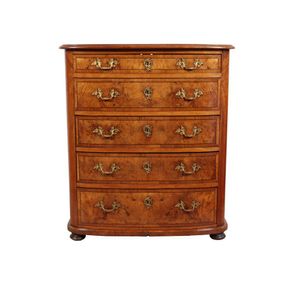Biedermeier Burr Walnut Chest of Drawers
Chest of drawers, late 19th century Biedermeier, burr walnut, five drawer bow fronted, ormolu handles and escutcheons, height 115 cm, width 101 cm, depth 53 cm
You must be a subscriber, and be logged in to view price and dealer details.
Subscribe Now to view actual auction price for this item
When you subscribe, you have the option of setting the currency in which to display prices to $Au, $US, $NZ or Stg.
This item has been sold, and the description, image and price are for reference purposes only.
- Burr - Burr (or in the USA, burl) is the timber from the knotted roots or deformed branch of the tree, which when cut, displays the small circular knots in various gradations of colour. It is always cut into a decorative veneer, most commonly seen as burr walnut on 19th century furniture.
- Bow Front - The front is shaped in a gentle curve or bow. Introduced during the 18th century, the bow-front is associated with furniture of the Hepplewhite and Sheraton period, though of course the form continued to be used throughout the 19th century. Bow-fronted pieces are usually veneered, although some were cut from the solid wood. Where veneer is used, the carcase is cut either from pine or deal, or sometimes the front was built up and shaped with small timber 'bricks'. Commonly used on various types of furniture including chairs, settees, chests, side tables, sideboards and display cabinets.
- Ormolu - Ormolu was popular with French craftsmen in the 18th and 19th century for ornamental fittings for furniture, clocks and other decorative items. True ormolu is gilt bronze, that is bronze that has been coated with gold using a mercury amalgam. Due to the health risks associated with using mercury, this method of creating ormolu was discontinued in France in the 1830s. A substitute was developed consisting of about 75% copper and 25% zinc, however it was inferior to the bronze version. It was often lacquered to prevent it tarnishing.
- Escutcheons - An escutcheon is a plate, made of brass, wood, ivory or ebony, which fits into or over the h keyhole, to protect the edge of the timber keyhole from damage by continual insertions of the key. As a general rule you would expect these escutcheons to be sympathetic in design to the handles of the piece. From the early 19th century escutcheons were sometimes made from ivory, ebony, bone or contrasting wood, often cut in a diamond or shield shape and inlaid into the front. Ivory, in particular, will tend to discolour with age, and certainly should not show up as brilliantly white.
This item has been included into following indexes:
- chests of drawers, material - walnut 462
-
chests of drawers, period
- Biedermeier 40
- Victorian 1,167
-
chests of drawers, style
- bow front 270
- five drawer 283
